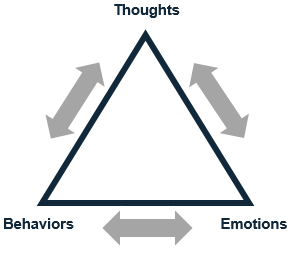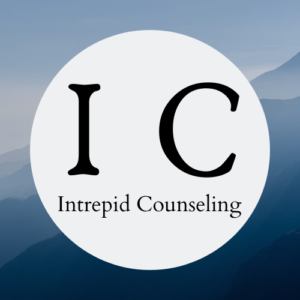Stories > Mental Health Series: The Triangle
Mental Health Self-Care: The Triangle
.mm
By Brianna White, Intrepid Counseling
Mental Health Geometry 1 – The Triangle
Psychologists and mental health therapists often use pictures and diagrams to show what is going on on the inside. This was the only type of imaging we had to describe our inner-life before brain imaging technology. Even though we understand the biology of the mind and emotions much better than we did 50, 30 or even 15 years ago, our old-school diagrams are as useful as ever. My next few blogs will cover some of these classic shapes. The first of these shapes is the Triangle. This blog will help you use it to understand yourself and make a self-care plan when you’re having a hard time.
One of the most popular shapes used to describe people’s emotions and behavior is the triangle. It is a way of diagraming how our thoughts, feelings and actions are related. Why does the Cognitive Triangle matter for TCKs? We’ve got a lot going on. Classic to the TCK experience is layers of complexity in many areas of life. In our relational lives, in our cultural experiences, in our spiritual belonging, in our logistical needs. The Cognitive Triangle is a tool we can use to orient ourselves when our thoughts and feelings get complicated too.

The Triangle (also sometimes called the Cognitive Triangle) connects these three elements: Thinking: What’s going through your head? / The Captions / Quotable / Inner chatter / Self-talk
Feeling: What does this mean? / Emotions / Reflexive / Body sensations / Nervous System Doing: Reactions / Observable / Objective / Coping skills (helpful and not-so helpful)
Thinking includes how you evaluate a situation, what you decide it means about your or what it means to you. Feelings include both emotions and body sensations (sad or sick / happy or energized), including sensing calm or threat. Doing means your actions, for example steps you take to feel better or protect yourself, connect and celebrate. It includes both reactions and plans and accidents. These elements form the points of the triangle and in the middle goes the situation – what is happening.
Here is how to use this tool when a situation is causing a problem or pain is happening in the area of your thoughts, actions or emotions. First draw a big, page-size triangle and write the situation in the middle of the triangle: Ex: all my friends have left for fall break and I’m still on campus. Next write down what you think about this at the top of your triangle: Ex: “No one cared about me enough to invite me to go with them.” Then write your feelings in the next box: use a feelings list if you are having a hard time naming your emotions. Ex: “Abandoned, lonely, depressed.” Finally write what you’re doing about this situation. Ex: Staying in my dorm room alone most of the day. That’s Triangle 1, or The Old Triangle.
Now for the New Triangle, where something has changed, other than the situation itself, to make you feel better. Take another sheet of paper, draw another triangle and write the exact same situation inside of it. Now look at the thoughts, the feelings and actions. Do you see anything that could change that might make things better? Maybe you remember a comforting thought. Ex: I actually enjoy having the room to myself for once. Or maybe there’s a reason why your first thought isn’t totally true. Ex: Someone did invite you to a trip that didn’t work out for you for some reason. These new thoughts can change your emotions. Thinking of it now as a rare weekend to yourself, you might start to feel a little bit peaceful, free or empowered. Or maybe you know an action you can take to feel less depressed, like catching up with far away friends, or getting out into the sunshine, taking matters into your own hands and finding an old friend or a cool nearby site you can visit.
Videos and other resources abound on social media, about ways to use the cognitive triangle to think in a new way and feel better. Here’s a good quick one: Thought Emotion Action Cycle CBT
If you notice you’re having a hard time thinking in a different way, your emotions are too hard to talk about or your actions are risky or dangerous, then it’s time to get help. If help from friends isn’t getting you all the way safe, or feeling better, it’s time to find a counselor/therapist. For information on how to do that, check out some of my past blogs all about getting yourself set up with mental health care. For help finding a TCK therapist in your area, please feel free to reach out to me at my website’s secure contact form.
_____________________________________________________________________


Brianna White
